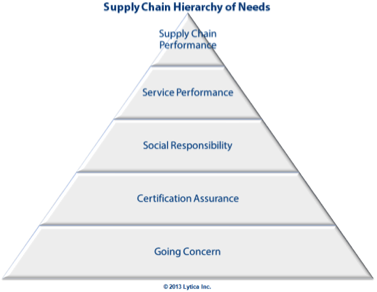We’ve talked before about the Supply Chain Hierarchy of Needs, but today we’re looking at the top-most levels, and the ways that they can enhance supply chain management.
The final levels of the pyramid (social responsibility, service performance, and supply chain performance) are critical. These deal with the supplier’s ability to align with your values, meet your performance expectations, and enable the realization of your design intent.
The social responsibility assessment includes two aspects. The first relates to a supplier’s capability in providing evidence that the social and environmental policies and practices they have in place are consistent with your needs. The second determines if a supplier has a value set that enables them to take actions consistent with your company’s requirements should unforeseen circumstances arise.
Obtaining access to a supplier’s policies and procedures is time consuming and tedious but generally can be achieved. Many companies post these documents on their website. The standard approach is to request copies of their policy on child labor, environmental protection, quality, corporate values, and other such indicators of social responsibility alignment; this addresses the evidence aspect.
The difficulty lies in the fact that it is easy for people and companies to say one thing and do another. The world is full of management consultants who create great value and mission statements that bear no similarity to reality. Too often these statements, posted on the office walls, are not integrated into the fabric of the company.
It is important to determine if the supplier you are assessing is a company that matches will with your organization and its values. This is very difficult to achieve, as it requires you to uncover the company’s true values and operating philosophy. In unforeseen circumstances, these are what drive the company’s choices and behavior. A company aligned with your values will behave in a way that you consider to be socially responsible. You need to visit the company, get to know the management team and consider their behavior in previous times of difficulty to truly assess their values and expected behavior.
Supplier performance can be measured objectively. Time-based metrics will tell you a lot about the company’s systems and business processes. Things must be designed and integrated well to provide fast service. A good metrics program should assess suppliers on at least four dimensions: operations, technology, financial, and social responsibility. Each dimension must have categories that can be objectively measured with data and the supplier rating should not average or weight the dimensions into a single score. Lytica’s metrics program reports a four-digit score; each dimension is a digit and its value between one and five (one being the best) becomes the lowest score in the category. This immediately flags poor performance issues and prevents averaging poor performance into an acceptable score.
The final test of your supply chain design is how well it works to your design intent. Again, metrics on your supply chain are vital. When your supply chain fails to meet your expectations you must investigate the problem to determine the root cause. If that cause is a supplier you must undertake corrective action. Ongoing issues are cause for supplier replacement.
For those of you interested in how to effect change in the base culture and overcome resistance, I refer you to my March 2011 blog, The Price Change Equation, and to writings on or by Richard Beckhard. The Beckhard Change Equation (Formula for Change) requires that:
- You have, and communicate, a compelling future state. (Why and in what way things are better in the future with the change?)
- Ensure dissatisfaction with the current state. (Why change?)
- Take some first steps. (Get some momentum going.)
Resistance to change is best addressed through communication of your progress. Why is the future better with improved supplier due diligence? What issues do you have today that could have been avoided? What are a few simple things that you could do to improve without disrupting everything? These are the ABCs of the Beckhard Equation.
Maslow also points to strategies for increasing acceptance of change. Take those with high security needs as an example; the change should be explained in terms of how job security is increased with enhanced diligence procedures. Conversely, for those with esteem or self-actualization needs, the change should be promoted based on the opportunity to grow and achieve. Be careful not to use the wrong motivational speech; don’t sell risk and opportunity to the security needs crowd!
With this as my final EBN blog, I want to thank all of you who have read and made comments on my blogs in the past; I hope that I’ve had some influence on your thinking.
Going forward, I plan to spend my writing time creating a book on supply management for purchasing professionals and electronic designers. For those of you interested in helping with this project, I plan to post draft chapters of the book on the Lytica website for review and critique. The project will take about a year and a chapter or two will be posted each month, I welcome you to participate.
By Ken Bradley – Lytica Inc. Founder/Chairman/CTO




